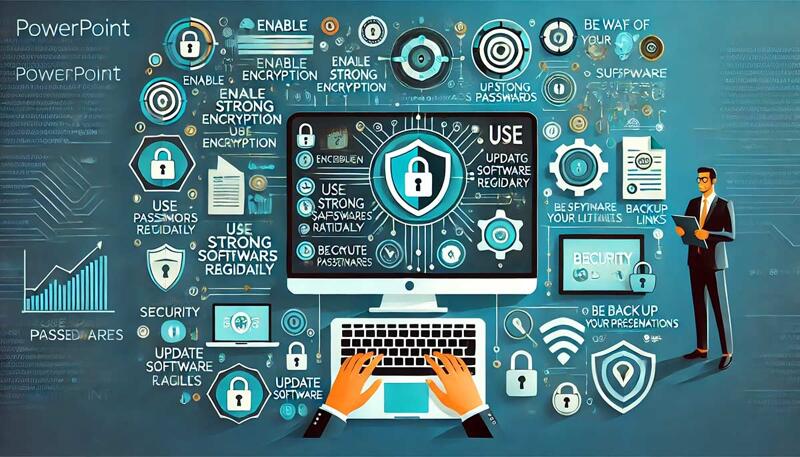Explore cybersecurity ideas and tips that are useful for PowerPoint users.
Author: Barrera Alcova
Product/Version: PowerPoint
The need to protect sensitive information extends beyond traditional cybersecurity measures to encompass every aspect of our digital interactions, including how we use presentation tools like Microsoft PowerPoint. As a staple in business and educational settings, PowerPoint presentations often contain confidential data that, if compromised, can lead to significant data breaches and reputational damage.

To safeguard your presentations from potential threats, here are essential cybersecurity tips that every PowerPoint user should implement.
The first step in protecting your PowerPoint presentations against cyber threats is to ensure that your software is always up to date. Developers regularly release updates that not only add new features but also fix security vulnerabilities that could be exploited by hackers. Enable automatic updates for Microsoft Office to guarantee that you’re always using the latest version with the highest level of security.
Protect your presentations with strong, unique passwords, especially if they contain sensitive or proprietary information. PowerPoint offers the option to password-protect your files, enhancing their security. For robust protection, create passwords that mix letters, numbers, and symbols, steering clear of simple words or predictable patterns. It's also advisable to use a password manager to securely organize and store your passwords.
Be mindful of how you share your PowerPoint files. Avoid sending sensitive presentations via email or unsecured file-sharing services. Instead, use trusted platforms that offer secure links and allow you to control who can view or download your file. Additionally, consider disabling copying or editing when sharing your presentation to further protect your information.
Frequent backups are crucial for data recovery following a cyberattack. Safeguard your presentations by storing them in various protected locations, including encrypted external hard drives or cloud storage services that provide end-to-end encryption. This practice enables you to restore your data swiftly and minimize losses should your files are compromised.
Cybercriminals often use phishing attacks, a common cyber security threat, to gain access to your computer and files. Be cautious of unsolicited emails that ask you to download PowerPoint attachments or click on links, even if they appear to come from known contacts. Verify the sender’s identity and scan attachments with antivirus software before opening them to protect against these malicious tactics.
When downloading templates or add-ins for PowerPoint, always use trusted sources. Third-party add-ons can contain malware that, once installed, can compromise your system. Download add-ins directly from the Microsoft Store or from reputable developers with positive reviews and known track records.
Make use of PowerPoint’s built-in security features. For instance, the “Protected View” feature opens files from potentially unsafe locations in a restricted mode, preventing malicious code from executing. Also, consider using the “Information Rights Management” (IRM) feature to prevent unauthorized access and editing of your presentations.
Finally, the best defense against cyber threats is awareness. Educate yourself and your team about the latest cybersecurity practices and potential threats. Regular training sessions can help users to recognize and respond to security risks effectively.
By implementing these cybersecurity tips, you can significantly enhance the security of your PowerPoint presentations and protect your information from unauthorized access and cyber threats. Always stay vigilant and proactive in your cybersecurity practices to ensure your digital presentations are secure.



Microsoft and the Office logo are trademarks or registered trademarks of Microsoft Corporation in the United States and/or other countries.